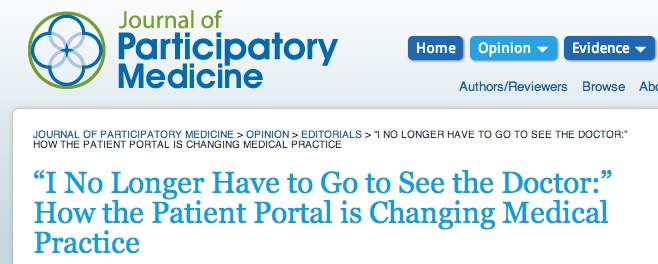SPM co-founder Charlie Smith (Charles W. Smith, MD) was “Doc Tom” Ferguson’s own physician, and currently serves as co-Editor-in-Chief of our Journal of Participatory Medicine. He’s just published a brief but important editorial in the journal. It begins (emphasis added):
“Not long ago, the only options my patients had for communicating with me were to come in to the office or relay a message through the office staff. The result is a cumbersome system that most patients avoid using unless there is a major problem or crisis to address.
“But, since recently introducing the patient portal in our electronic medical record, my practice has changed substantially. My patients tell me it’s for the better. Admittedly, there is the additional daily burden of responding to lab results, refill requests, and patient questions. But each of these is also a major improvement in efficiency and effectiveness of information flow, which is fundamental for any patient who aspires to be “’participatory.’”
He goes on to describe the challenges as well as the benefits.
If you (patient or provider) are starting to use a portal, I suggest you print this editorial and share it with others:
- Patients: Share it with your clinicians as an example of someone who’s on the front lines, working at it.
- Providers: Share it with peers as a platform for discussion of both the challenges and the benefits.
“Long ago my boss told me…”
Charlie’s editorial vividly recalled for me an event I spoke at earlier this month, the HCI Summit sponsored by Healthcare Informatics magazine and its parent Vendome Media. Another speaker was Russ Branzell, CEO of the informatics executive organization CHIME. In his talk he said that once when he was in sales he had a boss who said that any doctor he talked to would want to know this:
- Did you save me, or cost me, time?
- Did you save me, or cost me, money?
- Did you make my patients better or worse?
And, his boss said, for almost all doctors #3 trumps #1 and 2.
A patient portal, with secure messaging and patient access to information, is the right thing to do. It’s a feature that’s built into all medical record systems; the practice only needs to say “Yes, switch it on.” After all, as SPM co-founder Dr Danny Sands says, “How can patients participate if they can’t see the information?”
Charlie is also on Twitter as @eDocAmerica, the eDocAmerica.com website.







So, here’s a question. There is a growing movement to create synchronous (live) video consults, something Tom Ferguson imagined more than 15 years ago.
In addition to the portal, how valuable would this service be? How would it work financially?
Would love some feedback.